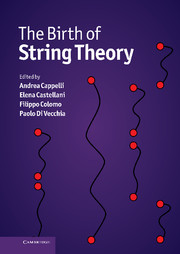Book contents
- Frontmatter
- Contents
- List of contributors
- Photographs of contributors
- Preface
- Abbreviations and acronyms
- Part I Overview
- EARLY STRING THEORY
- Part II The prehistory: the analytic S-matrix
- Part III The Dual Resonance Model
- Part IV The string
- TOWARDS MODERN STRING THEORY
- Part V Beyond the bosonic string
- 27 Introduction to Part V
- 28 From dual fermion to superstring
- 29 Dual model with fermions: memoirs of an early string theorist
- 30 Personal recollections
- 31 Aspects of fermionic dual models
- 32 The dual quark models
- 33 Remembering the dawn of relativistic strings
- 34 Early string theory in Cambridge: personal recollections
- Part VI The superstring
- Part VII Preparing the string renaissance
- Appendix A Theoretical tools of the Sixties
- Appendix B The Veneziano amplitude
- Appendix C From the string action to the Dual Resonance Model
- Appendix D World-sheet and target-space supersymmetry
- Appendix E The field theory limit
- Index
30 - Personal recollections
from Part V - Beyond the bosonic string
Published online by Cambridge University Press: 05 May 2012
- Frontmatter
- Contents
- List of contributors
- Photographs of contributors
- Preface
- Abbreviations and acronyms
- Part I Overview
- EARLY STRING THEORY
- Part II The prehistory: the analytic S-matrix
- Part III The Dual Resonance Model
- Part IV The string
- TOWARDS MODERN STRING THEORY
- Part V Beyond the bosonic string
- 27 Introduction to Part V
- 28 From dual fermion to superstring
- 29 Dual model with fermions: memoirs of an early string theorist
- 30 Personal recollections
- 31 Aspects of fermionic dual models
- 32 The dual quark models
- 33 Remembering the dawn of relativistic strings
- 34 Early string theory in Cambridge: personal recollections
- Part VI The superstring
- Part VII Preparing the string renaissance
- Appendix A Theoretical tools of the Sixties
- Appendix B The Veneziano amplitude
- Appendix C From the string action to the Dual Resonance Model
- Appendix D World-sheet and target-space supersymmetry
- Appendix E The field theory limit
- Index
Summary
When I look back at my involvement in the subject of string theory, what strikes me most is that the process of discoveries appears to me rather erratic in the details of who actually makes such or such discovery and when, depending on sometimes strange coincidences. On the other hand, at the level of published work the evolution of scientific knowledge is generally rather smooth and a posteriori natural. Over the decades, I have witnessed several other examples of coincidences that have been crucial in scientific progress. This Chapter is thus in some sense the opposite of Freeman Dyson's article ‘Missed opportunities’ [Dys72] in which he describes contributions he did not make because such coincidences which in all likelihood should have occurred actually did not occur.
In 1968–1969 I was working with Joël Scherk on our research work for our PhD in Orsay under the guidance of Claude Bouchiat and Philippe Meyer. The subject was electromagnetic and final state interaction corrections to nonleptonic kaon decays. We were classmates in our last year as students at the École Normale and good friends. We enjoyed working together a lot. While we were finishing our thesis work, we became very interested in the explosion of activity which followed the original Veneziano paper [Ven68], together with Claude Bouchiat and Daniele Amati, who was spending a sabbatical year in Orsay.
- Type
- Chapter
- Information
- The Birth of String Theory , pp. 373 - 377Publisher: Cambridge University PressPrint publication year: 2012



